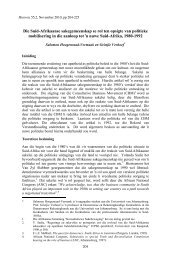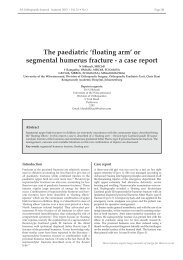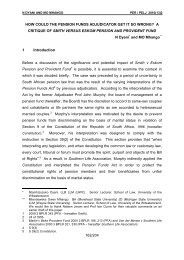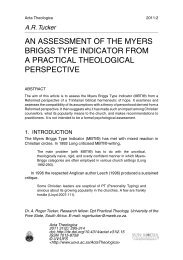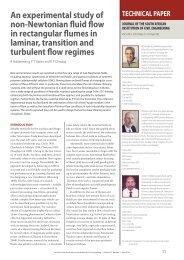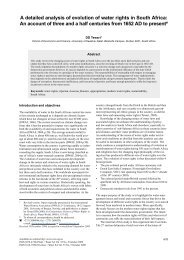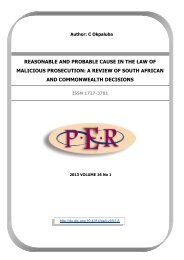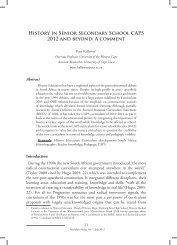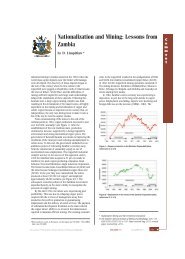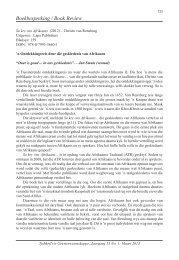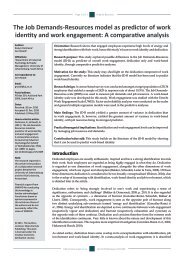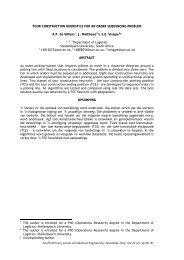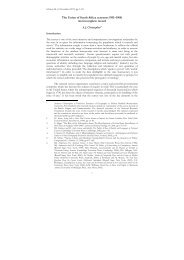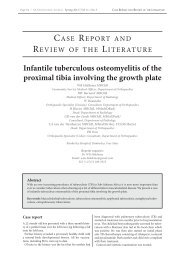Frances Baard's and Helen Joseph's struggle against apartheid ...
Frances Baard's and Helen Joseph's struggle against apartheid ...
Frances Baard's and Helen Joseph's struggle against apartheid ...
Create successful ePaper yourself
Turn your PDF publications into a flip-book with our unique Google optimized e-Paper software.
Musiiwa - <strong>Frances</strong> Baard’s <strong>and</strong> <strong>Helen</strong> Joseph’s <strong>struggle</strong><br />
characterizes human existence”. 40 It seeks to bring to the fore the relationship between a<br />
method of inquiry <strong>and</strong> the conditions that influence people’s lived experiences. In the<br />
case of this article then, hermeneutics begs the question: What is the relationship<br />
between Baard’s life history <strong>and</strong> Joseph’s autobiography, <strong>and</strong> their perception of their<br />
experiences of the <strong>struggle</strong> <strong>against</strong> <strong>apartheid</strong>? To be more explicit: What kind of<br />
knowledge do a life history <strong>and</strong> an autobiography bring to the fore if they depend on<br />
people’s perception <strong>and</strong> interpretation of their lived experiences? For example, the 1956<br />
anti-pass campaigns constitute an important women dominated epoch in the <strong>struggle</strong><br />
<strong>against</strong> <strong>apartheid</strong>, but how do <strong>Helen</strong> Joseph <strong>and</strong> <strong>Frances</strong> Baard perceive <strong>and</strong> present<br />
their experiences of the <strong>struggle</strong> <strong>against</strong> <strong>apartheid</strong>? The question of women’s<br />
representation of the ways in which they perceive <strong>and</strong> interpret the experiences of their<br />
<strong>struggle</strong> <strong>against</strong> <strong>apartheid</strong> underlies the hermeneutic aspect of this article.<br />
With regard to methods of historical inquiry, hermeneutics posits two basic<br />
tenets. The first is that a life history <strong>and</strong> an autobiography are influenced by subjectivity.<br />
However, the life history poses a significant epistemological issue in hermeneutics.<br />
Central to hermeneutics in life histories is the existence of different subjective worlds that<br />
dwell on the use of predetermined questions or ideas. As Gelya Frank notes: “unlike the<br />
autobiography, with which it is frequently grouped, the life history is a collaboration<br />
involving the consciousness of the investigator as well as the subject.” 41 The subject in a<br />
life history has to contend not only with her subjective views, but also with the<br />
interviewer who also has her own subjective views about the world. This is well<br />
illustrated in the introductory chapter to Baard’s life history when Barbie Schreiner, the<br />
researcher, becomes the feminist spokesperson who ascribes a Western oriented identity<br />
on Baard. She explains: “This book tells the story of <strong>Frances</strong> Baard, a black South African<br />
woman who was a trade unionist ...”. 42 In that process, she shows that any kind of<br />
methodological inquiry informed by theoretical pre-underst<strong>and</strong>ing imposes an alien set of<br />
meanings (categories such as gender, race or class) on individuals, <strong>and</strong> in so doing fails to<br />
bring the subject’s own truth of herself. Baard does not seem to contest the ascription,<br />
“black”, but rather proudly re-inscribes <strong>and</strong> crystallises “blackness” on herself <strong>and</strong> people<br />
of her own race.<br />
The second tenet of hermeneutics is that as a philosophical discipline, it brings<br />
into focus the personal narrative as a text or discourse to be interpreted. In other words,<br />
a life history or an autobiography is not a historical text in its own right, but “it is a text or<br />
document” 43 that communicates self-ascribed information about a particular<br />
phenomenon. With reference to Baard’s life history, Schreiner says that “this book does<br />
not only tell her story. It tells part of our history”. 44 Similarly Joseph attests that her<br />
autobiography, while recounting her own story, is “even more” a history of the South<br />
African <strong>struggle</strong> <strong>against</strong> racist minority rule. 45 If the life history or the autobiography is<br />
not the history, what is the text intended to communicate? The text portrays women’s<br />
perception of their experiences as witnesses <strong>and</strong> constructors of historical legacies that<br />
inform the trajectory of South Africans’ <strong>struggle</strong> for independence. However, this<br />
approach gives primacy to the interpretive process that intervenes between the<br />
interpreter <strong>and</strong> that which is to be interpreted, where an underst<strong>and</strong>ing of an event or<br />
40. P. Ricoeur, “History <strong>and</strong> Hermeneutics”, The Journal of Philosophy, 73, 19, 1976, p 683.<br />
41. G. Frank, “Finding the Common Denominator: A Phenomenological Critique of Life History<br />
Method”, Ethos, 7, 1, 1979, p 70.<br />
42. Baard <strong>and</strong> Schreiner, My Spirit is Not Banned, “Introduction” (emphasis added).<br />
43. Frank, “Finding the Common Denominator”, p 70.<br />
44. Baard <strong>and</strong> Schreiner, My Spirit is Not Banned, “Introduction” (emphasis added).<br />
45. Joseph, Side by Side, Part 1, Chapter 10, “Trial by Detention”.<br />
73



